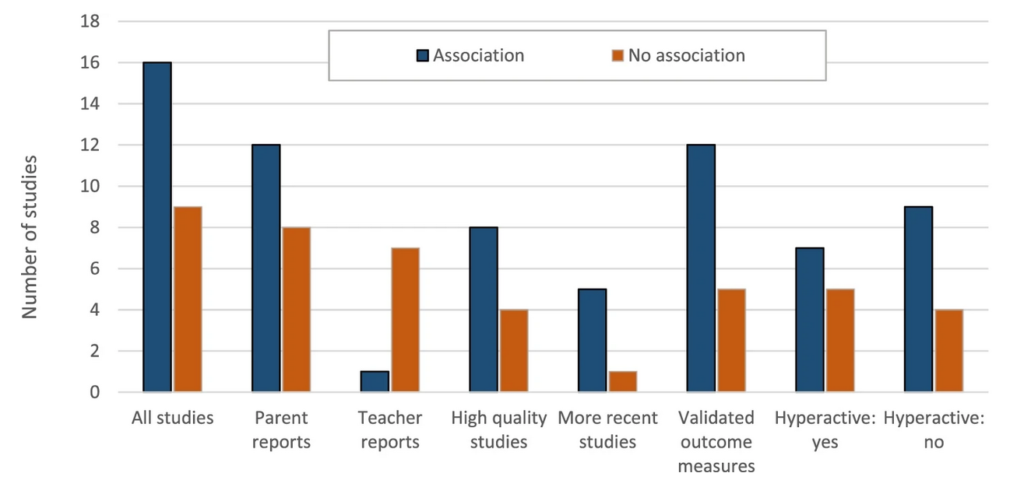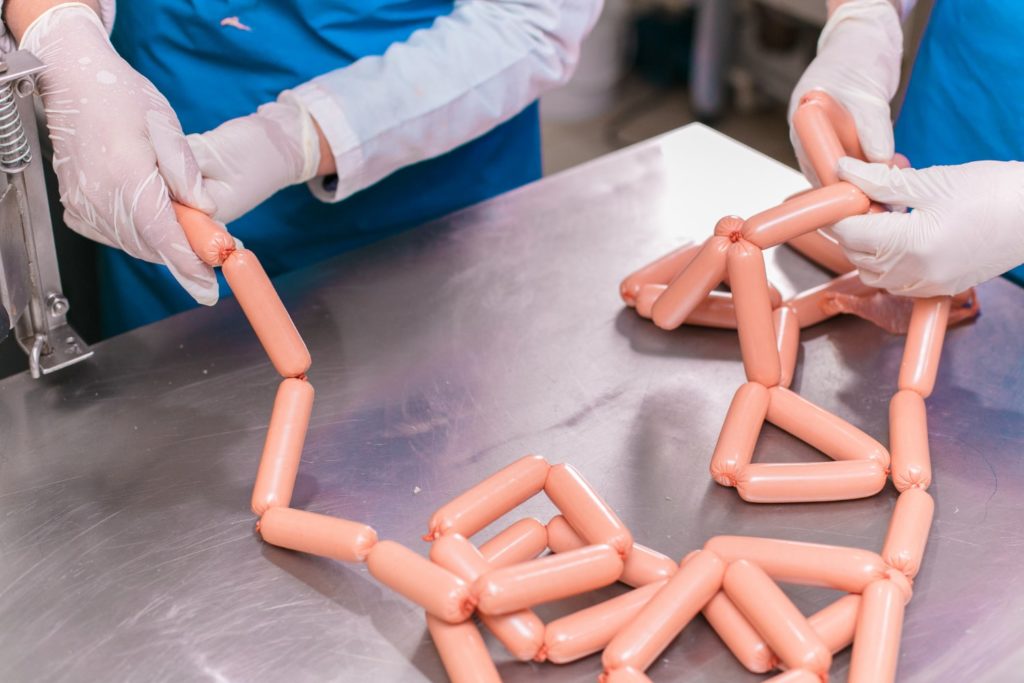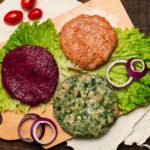
Michaela Dvorakova
(MFood Tech, R&D Specialist)
In this part, we will be looking more closely at food colours and food preservatives, and see which ones have been banned so far, and which colours and additives are still being used despite certain studies suggesting otherwise.
Banned Food Colours and current studies
Food colours can be natural or artificial and are added to foods to enhance their natural colours, add colour to colourless products and help identify flavours (for example red colour for strawberry or yellow for lemon).[1]
List of additives permitted in NZ consists of 49 food colourings.[2]
The main risks discussed with artificial dyes are hyperactivity in children, as well as cancer and allergies.
The effect of food dyes on hyperactivity has been studied for more than 45 years. Several studies have found a significant association.
In 2022, a California study conducted a systematic review of the epidemiologic research on synthetic food dyes and neurobehavioral outcomes in children with or without identified behavioural disorders. This was identified in 29 studies.

Sixteen studies (64%) identified some evidence of a positive association, and in 13 (52%) studies the association was statistically significant.
These studies support a relationship between food dye exposure and adverse behavioural outcomes in children.[3]
Food dyes may cause behavioral changes in children
Animal toxicology literature provides additional support for effects on behaviour. Together, the human clinical trials and animal toxicology literature support an association between synthetic food dyes and behavioural impacts in children.
However, EFSA (The European Food Safety Authority) and FDA (The United States Food and Drug Administration) have stated that there is not enough evidence to conclude that food dyes are unsafe since most food dyes that are used in the food industry have not shown to cause any adverse effects in toxicity studies.
There are some concern about allergic reactions, skin issues and exacerbating asthma symptoms due to possible contaminants in:
Red 40
Other names:
- Allura Red AC
- E129
- Disodium 6-hydroxy-5-[(2-methoxy-5-methyl-4-sulfophenyl)azo]-2-naphthalenesulfonat
Yellow 5
Other names:
- Tartrazine
- E102
- Trisodium 5-hydroxy-1-(4-sulfonatophenyl)-4-[(E)-(4-sulfonatophenyl)diazenyl]-1H-pyrazole-3-carboxylate)
Yellow 6
Other names
- Sunset yellow FCF
- E110
- Disodium 6-hydroxy-5-[(4-sulfophenyl)azo]-2-naphthalenesulfonate)
Also, benzidine, 4-aminobiphenyl and 4-aminoazobenzene are present in food colours, and though only in low quantities, they are potential carcinogens.[4]
There is currently no evidence that colour additives allowed in food can cause cancer.
Number of lifetime toxicity/carcinogenicity animal studies were done between 1973-1991. These rats studies focused on the impact of:
- Blue 1
- Red 40
- Yellow 5
- Yellow 6
In conclusion, no cancer-causing effects were observed.[5,6,7,8,9]
However, it’s also important to say that the intake of dyes has dramatically increased. Because of that EFSA decided to re-evaluate all food colours authorised before 2009. Overall, the ANS Panel (The Panel on Food Additives and Nutrient Sources added to Food) re-assessed 41 food colours, taking into account new studies where available.[10]
Color | E-code | Risk | Banned |
Patent Blue V | E131 | Anaphylaxis | 2003 |
Brown FK | E154 | Carcinogenic | 2011 |
Canthaxanthin | E161 | Aplastic anaemia | 1993 |
Litholrubine BK | E180 | Carcinogenic | 1987 |
Sudan dyes | – | Carcinogenic | 2005 |
Auramine O | – | Carcinogenic | 1994 |
Orange B | – | Carcinogenic | 1978 |
Rhodamine B | – | Carcinogenic | 1987 |
Violet 1 | – | Carcinogenic | 1973 |
Sudan dyes (banned)
Sudan dyes are synthetically produced azo dyes, used in the past for colouring various foodstuffs, especially curry and chilli powder.
Human gastrointestinal tract bacteria play a major role in the degradation of Sudan dyes. The degradation of Sudan dyes by human gastrointestinal tract bacteria generates carcinogens and teratogens (causing abnormality to the fetus during pregnancy).[11,12]
Due to this fact, Sudan I was considered by the joint FAO/WHO Expert Committee on Food Additives (JECFA) in 1973 to be unsafe for use in food.
However, in some parts of the world Sudan dyes are still used illegally to colour particular foods.

Source: Silva, A. Identification of Synthetic Food Colours in Selected Confectioneries and Beverages in Jaffna District, Sri Lanka. (2019)
Auramine O (banned)
Auramine O (AO) is a banned food additive and has been classified as an illegal colourant.
Due to its yellow colour, Auramine O was used for colouring spices. Several studies have shown that Auramine O causes liver tumours in mice and it’s possibly carcinogenic to both mice and humans.
During the study, human lung cancer cells were treated with Auramine O. After 7 days, scientists compared cell numbers, and Auramine O showed to significantly promote lung cancer malignancy.[13]

Rhodamine B (banned)
Rhodamine B was classified as a group 3 carcinogen by IARC (The International Agency for Research on Cancer) in 1987 and is considered to be:
- carcinogenic
- genotoxic
- neurotoxic inducer or toxin in animals
Rhodamine B was used as the colourant in food such as chilli powder, chilli oil and similar foods.[14]
Banned Preservatives and current studies
Preservatives are used to inhibit microbial growth and extend the shelf life. Their function is based on preventing or slowing down the growth of microorganisms.
Certain studies observed the harmful effects of preservatives on human health.
Preservatives | E-code | Risk | Banned |
Ethyl p-hydroxybenzoate | E214 | Genotoxicity | 2004 |
Sodium ethyl p-hydroxybenzoate | E215 | Genotoxicity | – |
Sodium methyl p-hydroxybenzoate | E219 | Genotoxicity | – |
Calcium sulphite | E226 | Allergies | – |
Calcium hydrogen sulphite | E227 | Allergies | – |
Biphenyl; diphenyl | E230 | Carcinogenic | 1979 |
Orthophenyl phenol | E231 | Carcinogenic | 2011 |
Sodium orthophenyl phenol | E232 | Carcinogenic | 2011 |
Hexamethylene tetramine | E239 | Carcinogenic | 1973 |
Boric acid | E284 | Organ harm | 1961 |
Sodium tetraborate; borax | E285 | Nausea, vomiting, kidney failure | 1961 |
DEPC | – | Carcinogenic | 1972 |
NDGA | – | Kidney damage | 1968 |
Sodium nitrate (still in use)
Sodium nitrate is a preservative used in lunch meats, sausages, bacon and/or canned food to prevent botulism.
The issue with sodium nitrate is the potential production of carcinogenic N-nitrosamines under certain conditions. Under acidic pH in the mouth or stomach, nitrite or nitrates added to food or naturally occurring may combine with amines to form nitrosamines.
The World Health Organisation (WHO) recommended the upper limit of concentration of daily nitrate and nitrite uptake to be 3.7 mg/kg and 0.06-0.07 mg/kg, respectively.[15]
However, recent epidemiological investigations of nitrates and tumours have shown no clear evidence that dietary nitrate could increase the occurrence of tumours.
If you would like to know more about nitrites and nitrates, we suggest reading 5 Most Common Food Additives in our Food (and should we avoid them)? (Part 1).
Sodium benzoate (still in use)
Sodium benzoate is used to extend the shelf life of tomato sauce.
It’s considered safe, but scientists have shown that when it’s combined with vitamin C and exposed to elevated temperatures or light, it can create carcinogenic benzene.[16]
RELATED — Vitamin C (Immunity and Collagen booster)
Many studies have been done on this, and in 2012 scientists from Florence analyzed 28 soft drinks. They found that beverages with both sodium benzoate and ascorbic acid have higher concentrations of benzene and 2 out of 28 drinks tested have a concentration level above the European limit.[17]
Also, for the last 40 years, there have been debates about the connection between sodium benzoate and hyperactivity. Scientists from the University of Southampton have shown evidence of increased levels of hyperactivity in young children consuming mixtures of some artificial food colours and sodium benzoate.
The study involved studying levels of hyperactivity in 153 three-year-olds and 144 eight-year-olds. Children were placed on a 6-week-long special diet, free from additives used for this study.
The additives were sunset yellow, carmoisine, tartrazine, ponceau 4R, quinoline yellow, allura red AC and sodium benzoate.
After this period children were then given a drink each day that either contained one of two mixtures of food colours and benzoate preservatives, or just fruit juice.
The results show that when the children were given the drinks containing the test mixtures, in some cases their behaviour was significantly more hyperactive.[18]
Nonetheless, these preservatives are still being researched, and more studies are needed.
Ortho-phenylphenol (banned)
Ortho-phenylphenol is a food additive approved by the European Union, but banned in Australia/New Zealand.
It’s an antifungal synthetic preservative, used primarily to prevent the growth of penicillium mould in citrus fruits.
Main reason for banning this additive in Australia and New Zealand is due to its dangerous effects on bladder and livers.
WHO has classified ortho-phenylphenol as unlikely to present an acute hazard in normal use. Ortho-phenylphenol is not classifiable as to its carcinogenicity to humans. However, this statement is based on limited published literature.
Ortho-phenylphenol was tested for carcinogenicity in one experiment in mice and two experiments in rats by administration in the diet. Benign and malignant bladder tumours were induced at significant incidence in male rats in one study.[19]
Ethyl p-hydroxybenzoate (Ethyl parabene) (banned)
Ethyl p-hydroxybenzoate belongs to a class of compounds known as parabens. It is used as an antifungal preservative.
While studies on parabens in cosmetics and personal care products are many, there are not many studies that have looked at parabens in our food supply.
However, some side effects have been observed, such as the risks of breast cancer and/or decreasing sperm levels.
In vitro studies conducted by Bao-Liang et al. (1989) proved that methylparaben, ethylparaben, propylparaben and butylparaben are effective spermicides for human spermatozoan.[20]
Another study from 2020 suggested that ethylparaben and other endocrine disruptor compounds were associated with female infertility, but the authors admit that more studies need to be carried out.[21]
Parabens in food might lead to infertility
There is a lack of solid data that can prove the increase in breast cancer caused by parabens.

Source: Lan, L. Urinary paraben derivatives in pregnant women at three trimesters: Variability, predictors, and association with oxidative stress biomarkers. (2022)
However, some in vitro studies have started to verify that parabens can interact negatively with some body functions or cells, which could lead to the formation of cancer.[22]
Related Questions
1. What are the harmful effects of artificial food coloring?
Food colourings are mostly discussed in connection with children’s hyperactivity and possible carcinogenicity.
2. How can I colour my food black naturally?
Common natural black dye is black charcoal or squid ink.
3. What are natural preservatives that can be used for meat curing?
Salt is a common natural preservative for meat, along with plant extracts and freezing.
4. What is the safest food preservative?
Safe food preservatives are salt, sugar or plant extracts. But even with salt and sugar, it is important to control your daily intake.
5. What are Top 5 natural food preservatives?
Salt, sugar, vinegar, plant extracts and oils.
If you are looking for part one of this article, you can find it here — Why are food additives getting banned? (Part 1).
Michaela is a qualified food technologist, originally from the Czech Republic, where she successfully graduated and earned a Master’s degree from University of Chemistry and Technology. Michaela’s field of study was chemistry and analysis of food and natural products, and upon finishing her studies she became a part of an R&D team focusing on nutritional plant-based food.
Healthy lifestyle, sustainability, and human and animal well-being are the main reasons why Michaela is interested in natural food and products, with a minimum amount of processing. Also, being such a food lover, she believes that food can be healthy and delicious in equal measure, and at the same time, good and friendly to the environment, which is a win-win for all of us.
References
(1) Food Additives – Specialty Chemicals Update Program (SCUP) | S&P Global (spglobal.com). Retrieved from https://www.spglobal.com/commodityinsights/en/ci/products/chemical-food-additives-scup.html
(2) Food Standards Australia New Zealand. Food Colours.
(3) Miller, M.D., Steinmaus, C., Golub, M.S. et al. Potential impacts of synthetic food dyes on activity and attention in children: a review of the human and animal evidence. Environ Health 21, 45 (2022). Retrieved from https://doi.org/10.1186/s12940-022-00849-9
(4) Kobylewski S, Jacobson MF. Toxicology of food dyes. Int J Occup Environ Health. 2012 Jul-Sep;18(3):220-46. doi: 10.1179/1077352512Z.00000000034. PMID: 23026007.
(5) Potera C. The artificial food dye blues. Environ Health Perspect. 2010 Oct;118(10):A428. doi: 10.1289/ehp.118-a428. PMID: 20884387; PMCID: PMC2957945.
(6) Peiperl MD, Prival MJ, Bell SJ. Determination of combined benzidine in FD&C Yellow No. 6 (Sunset Yellow FCF). Food Chem Toxicol. 1995 Oct;33(10):829-39. doi: 10.1016/0278-6915(95)00051-3. PMID: 7590527.
(7) Lancaster FE, Lawrence JF. Determination of benzidine in the food colours tartrazine and sunset yellow FCF, by reduction and derivatization followed by high-performance liquid chromatography. Food Addit Contam. 1999 Sep;16(9):381-90. doi: 10.1080/026520399283867. PMID: 10755129.
(8) Prival MJ, Peiperl MD, Bell SJ. Determination of combined benzidine in FD & C yellow no. 5 (tartrazine), using a highly sensitive analytical method. Food Chem Toxicol. 1993 Oct;31(10):751-8. doi: 10.1016/0278-6915(93)90147-q. PMID: 8225134.
(9) Lancaster FE, Lawrence JF. Determination of total non-sulphonated aromatic amines in tartrazine, sunset yellow FCF and allura red by reduction and derivatization followed by high-performance liquid chromatography. Food Addit Contam. 1991 May-Jun;8(3):249-63. doi: 10.1080/02652039109373975. PMID: 1778264.
(10) European Food Safety Authority. Re-evaluation of food colours: EFSA completes major programme. Retrieved from https://www.efsa.europa.eu/en/press/news/160914-0
(11) Fonovich TM. Sudan dyes: are they dangerous for human health? Drug Chem Toxicol. 2013 Jul;36(3):343-52. doi: 10.3109/01480545.2012.710626. Epub 2012 Sep 5. PMID: 22947042.
(12) Pan H, Feng J, He GX, Cerniglia CE, Chen H. Evaluation of impact of exposure of Sudan azo dyes and their metabolites on human intestinal bacteria. Anaerobe. 2012 Aug;18(4):445-53. doi: 10.1016/j.anaerobe.2012.05.002. Epub 2012 May 23. PMID: 22634331; PMCID: PMC5870115. Retrieved from https://www.ncbi.nlm.nih.gov/pmc/articles/PMC5870115/
(13) Tung JC, Huang WC, Yang JC, Chen GY, Fan CC, Chien YC, Lin PS, Candice Lung SC, Chang WC. Auramine O, an incense smoke ingredient, promotes lung cancer malignancy. Environ Toxicol. 2017 Nov;32(11):2379-2391. doi: 10.1002/tox.22451. Epub 2017 Jul 19. PMID: 28722353; PMCID: PMC5655719. Retrieved from https://www.ncbi.nlm.nih.gov/pmc/articles/PMC5655719/
(14) National Toxicology Program. NTP Toxicology and Carcinogenesis Studies of Rhodamine 6G (C.I. Basic Red 1) (CAS No. 989-38-8) in F344/N Rats and B6C3F1 Mice (Feed Studies). Natl Toxicol Program Tech Rep Ser. 1989 Sep;364:1-192. PMID: 12692640.
(15) Karwowska M, Kononiuk A. Nitrates/Nitrites in Food-Risk for Nitrosative Stress and Benefits. Antioxidants (Basel). 2020 Mar 16;9(3):241. doi: 10.3390/antiox9030241. PMID: 32188080; PMCID: PMC7139399. Retrieved from https://www.ncbi.nlm.nih.gov/pmc/articles/PMC7139399/
(16) Salviano Dos Santos VP, Medeiros Salgado A, Guedes Torres A, Signori Pereira K. Benzene as a Chemical Hazard in Processed Foods. Int J Food Sci. 2015;2015:545640. doi: 10.1155/2015/545640. Epub 2015 Feb 18. PMID: 26904662; PMCID: PMC4745501. Retrieved from https://www.ncbi.nlm.nih.gov/pmc/articles/PMC4745501/
(17) Bonaccorsi G, Perico A, Colzi A, Bavazzano P, Di Giusto M, Lamberti I, Martino G, Puggelli F, Lorini C. Benzene nelle bibite analcoliche: un’indagine fiorentina [Benzene in soft drinks: a study in Florence (Italy)]. Ig Sanita Pubbl. 2012 Jul-Aug;68(4):523-32. Italian. PMID: 23073373.
(18) University of Southampton. Major study indicates a link between hyperactivity in children and certain food additives. Retrieved from https://www.southampton.ac.uk/news/2007/09/hyperactivity-in-children-and-food-additives.page
(19) Lambert AC, Eastmond DA. Genotoxic effects of the o-phenylphenol metabolites phenylhydroquinone and phenylbenzoquinone in V79 cells. Mutat Res. 1994 Oct;322(4):243-56. doi: 10.1016/0165-1218(94)90100-7. PMID: 7523918.
(20) Song BL, Li HY, Peng DR. In vitro spermicidal activity of parabens against human spermatozoa. Contraception. 1989 Mar;39(3):331-5. doi: 10.1016/0010-7824(89)90065-6. PMID: 2714092.
(21) Arya, Sushila, et al. “Exposure of US population to endocrine disruptive chemicals (Parabens, Benzophenone-3, Bisphenol-A and Triclosan) and their associations with female infertility.” Environmental Pollution 265 (2020): 114763. Retrieved from https://www.sciencedirect.com/science/article/abs/pii/S026974912030717X
(22) Lincho, J.; Martins, R.C.; Gomes, J. Paraben Compounds—Part I: An Overview of Their Characteristics, Detection, and Impacts. Appl. Sci. 2021, 11, 2307. Retrieved from https://doi.org/10.3390/app11052307







So good to hear this!